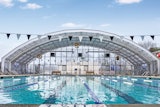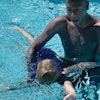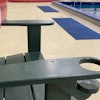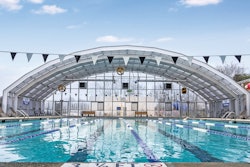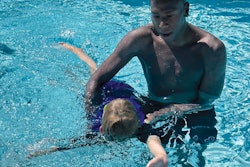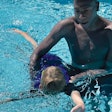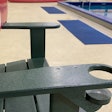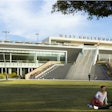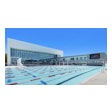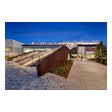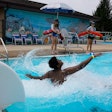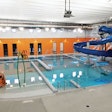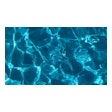Controlling the Indoor Pool Environment Requires an Understanding of Water Evaporation, Condensation and Migration

Do patrons walk into your athletic facility and immediately notice the smell of chlorine in the lobby air? After sitting in the stands at an indoor swim meet, do spectators complain that the atmosphere in your natatorium is uncomfortably hot and muggy? If you can answer yes to either of these questions, then you have an indoor pool out of control.
As the number of indoor aquatic centers continues to grow, so must facility operators' understanding of the dynamics of environmental conditions within these venues. The aquatic component may be only one of several activity spaces within a given facility, but inadequate control of the indoor pool can impact the air quality, aesthetics and success of the entire complex.
Moisture-laden air from the pool area can migrate throughout the building's interior, damaging building components along the way. The warning signs are many: Pool smells in the lobby indicate that the pool mechanical system is not working properly. Rusting lockers reveal that moist air is attacking ferrous metal. Sweating windows in the pool or observation areas show that the dew point (the temperature at which water vapor in the air condenses) is not being properly maintained.
Everyone understands that pool water evaporates into surrounding air. Less obvious, perhaps, is that successful control of the environment begins prior to the planning of aquatics programs, activities, water-play features and competitive events. At this early stage, important parameters relating to water surface area, water movement, water temperature, deck surface area, airflow and spectator comfort requirements combine to determine the aquatic space's evaporation rate and to dictate specifications of the heating, ventilation and air conditioning (HVAC) system to be installed in the facility. The impact of these parameters on construction budgets is significant, but even more important is their impact on the facility's long-term operating costs.
What follows is an overview of the most important factors at work within an indoor pool environment. A working understanding of these dynamics will help pool operators run their facilities at peak efficiency, and with few complications.
Evaporation Rate An aquatic facility's evaporation rate relates directly to the surface area of pool water and the volume of air surrounding it, as well as to the temperature of both air and water. Water evaporates faster from large surface areas and into large volumes of air. In addition, the warmer the water in relation to the air, the higher the rate of evaporation.
A third key factor in determining evaporation rate involves what function each body of water is designed to serve. Aquatic centers may boast a variety of pools and activity zones, including lap pools, leisure pools, wave pools, water slides, spas and lazy rivers. Each of these zones has a water surface that falls into one of two categories: smooth or moving. Smooth water is found in competitive pools, lap pools or wading pools in which the water surface is not agitated unless the pool is occupied by users. This type of pool typically has a low evaporation rate. Moving water in wave pools, water slides and lazy rivers, meanwhile, exhibits a higher rate of evaporation than smooth water.
For years, design engineers dealt with only smooth water, but the rise in popularity of leisure pools quickly brought moving, shooting, splashing and running water indoors. This created a need to calculate the evaporation rates of every body of water in a facility separately. In most cases, the evaporation rates of these pools take into consideration the relative air motion across the water surface. The faster the air is moving across the surface of the water, the higher the evaporation rate. Thus, the rate of evaporation is much higher from a play structure or moving-water feature than from a lap pool. Analysis has indicated increasing the air velocity across the water surface increases the evaporation rate by 8 percent or more. (The relationship of water and air temperature is still important, since pools with moving water are typically programmed with higher water temperatures - between 84 and 86 degrees Fahrenheit.)
Water feature manufacturers can supply information regarding flow rates in terms of gallons of water per minute running through their products. It's up to the design team to evaluate each moving water surface within the facility as to how fast water is moving over or through each feature. For example, the flow rate through a water slide is calculated by multiplying the length of the flume by its width. Analysis of the flow rate in relationship to the cross-sectional area of the slide allows the relative air motion speed to be determined and the evaporation rate to be calculated.
Successful aquatic centers are those that encourage participants to move from one activity zone to another. This causes deck areas to become wet. As a result, evaporation rate calculations must also account for all wet areas - decks, benches and other seating structures - within the building enclosure, as water evaporates from any wet surface. Detailed analysis reveals that inclusion of these wet areas can increase a facility's evaporation rate by as much as 55 percent.
Water and Air Temperature Established pool water temperature determines the setting of indoor space temperature, which is typically set 2 to 5 degrees higher than the pool water. If a facility has several bodies of water, each with its own temperature, the pool with the best combination of a large area and a high temperature should be selected as the basis for establishing the indoor air temperature. For example, if a facility has a lap pool (82 degrees), whirlpool (100 degrees), water slide (86 degrees) and a leisure pool (86 degrees), then the room temperature should be determined based on the leisure pool water temperature, since it is both large and relatively warm. Accordingly, the air temperature should be at least 2 degrees above the water temperature, or 88 degrees. Keep in mind that most patrons typically find indoor air temperatures exceeding 88 degrees uncomfortable over long periods of pool use.
If the relationship between pool water temperature and air temperature is not closely monitored and maintained, indoor conditions can become unbalanced. This results in condensation appearing on glass surfaces, increased humidity in the space, poor air quality and decreased HVAC efficiency. A simple solution is to maintain water temperatures in accordance with HVAC settings for space temperature and humidity. Several years ago, operators of an indoor competitive pool facility were complaining that their mechanical system was not functioning properly. The windows started to sweat, lockers were rusting, and people were complaining about the air quality in the pool environment. It was later discovered that the aquatics director had increased the pool's water temperature to 85 degrees after implementing programs for older adults and children, even though HVAC settings remained based upon 82-degree pool water. The facility operators were indeed correct that the HVAC system wasn't functioning properly; it wasn't designed to handle the resulting evaporation rate increase.
A good design baseline is to assume that all water surfaces - except whirlpools, spas and therapy pools - will maintain a water temperature of 86 degrees. A competitive pool typically requires water temperatures between 78 and 82 degrees. A whirlpool or spa may require water between 97 and 102; indoor leisure pools, between 84 and 86. Designing the majority of the pools to 86 degrees allows flexibility in modifying water temperatures to match aquatic programs. Unfortunately, most pool HVAC manufacturers design their systems based on 82-degree water temperatures, regardless of the type of pool. Water temperatures should be verified prior to the selection of the pool HVAC manufacturer, since a change in water temperature of 2 degrees results in an evaporation-rate increase of 7 percent.
Relative Humidity The most significant impact on evaporation rate within the pool environment is relative humidity, or the amount of moisture in the air. Low relative humidity increases the evaporation rate of water from the surface of pools and decks and from the skin of pool users. While air temperature may be set at 88 degrees, relative humidity of less than 50 percent can cause pool users to feel chilled, because rapid evaporation cools their skin. The increased evaporation from the pool, meanwhile, results in an increase in water usage and pool water heating.
On the other end of the scale, relative humidity above 60 percent can cause respiratory problems in pool users and force water vapor into other areas of the building. Participants may complain that the air feels muggy and that it is difficult for them to take deep breaths. The moist air permeates the building, since moisture-laden air naturally migrates toward drier air, in this case in air-conditioned areas and locker rooms. This vaporized water will condense on surfaces at or below the dew point in the pool area and in other spaces within the building.
It is important to establish the relative humidity level during the design phase and maintain the predetermined set point during operation. Relative humidity in the aquatics space should be maintained between 50 and 60 percent, and facility operators should insist that the HVAC system be designed based on a set relative humidity point of no more than 60 percent. Operators should be aware, however, that changing seasons will result in variations, as outdoor air is introduced as ventilation air. A reduction in relative humidity by 10 percent increases the evaporation rate by more than 30 percent.
Other Factors The type of pool HVAC system selected must take into account geographic location and weather conditions. Some locations in the northern portions of the United States benefit from mild summers and cold winters with low relative humidity. Facilities in these locations can use outdoor air to ventilate and dehumidify the pool environment. Facilities in southern locations, on the other hand, typically require HVAC systems that employ mechanical cooling and dehumidification. These systems use refrigerant-based equipment to remove the moisture from the pool air while introducing outside air through a system of ventilation ducts.
In any location, ventilation air should always be provided to an indoor pool space, and building codes require that air from the pool environment be exhausted. Exhaust air is replaced with outdoor air ventilated through the HVAC unit, and this fresh air reduces the levels of airborne contaminants in the pool environment. Failure to provide fresh air results in poor indoor air quality and can lead to respiratory problems among the pool's users.
In addition, the pool area should be maintained at a negative pressure relative to all surrounding areas. This is accomplished by returning slightly more air to the HVAC system from the pool area than from adjacent spaces. A simple means of verifying this pressure imbalance is to light a match outside any door opening in the pool area and check to see if the flame or smoke trail is drawn toward the natatorium. If not, the fan systems need to be adjusted to provide negative pressure. If this negative pressure is not achieved and maintained, the odor of chlorinated pool air can migrate throughout the facility. And if allowed to migrate even as far as adjacent locker rooms, this chlorinated air will attack the ferrous metals in lockers.
Ductwork in the pool enclosure must ensure adequate air movement, allowing the supply air to mix with air within the space. This is accomplished by supplying air both near the floor and ceiling within the space. To help reduce the potential of condensation forming on glass surfaces during cold weather - when dew point in the space is most critical - supply air should be directed toward windows, skylights and doors in a uniform distribution pattern. Perimeter supply registers directing air upward and parallel to the glass have been effective in reducing condensation on large windows.
Likewise, air returned to the HVAC system should be collected from high and low grills in the space. A high return removes moist air near the ceiling. The low return allows air to be removed from the level of the pool surface, where it assists with the removal of chemicals released during water treatment cycles. Air velocities across the pool should not exceed 25 feet per minute to avoid drafts on bathers. Competitive natatoriums with seating require enough perceptible return and supply air to avoid a stagnant, muggy atmosphere in observation areas.
The pool enclosure must be constructed with a vapor barrier, preventing water vapor from migrating through the floor, ceiling, walls or roof. Details of how the walls and roof are connected should be thoroughly reviewed by the design team during construction. If constructed improperly, this connection point may lead to water vapor migrating to the exterior of a building and damaging internal structural elements and the facade. It is not inconceivable that a pool area will have a dew point above 70 degrees, allowing condensation to form on any adjacent surfaces, equipment and materials exhibiting lower temperatures. This condensation can damage ceiling tiles, floor systems, wall finishes and structural components. All penetrations should be sealed at electrical boxes, ductwork, fire protection systems and plumbing lines, as well as around doors and above ceilings.
As noted here, the ultimate efficiency of the HVAC system will depend on many factors. Its manufacturer must be able to supply a product designed to operate according to the parameters previously mentioned. Operation and maintenance personnel must be adequately trained to operate whatever type of equipment is purchased. The equipment should be strategically located to provide easy access for routine maintenance and repairs; access should be provided from within the building via a stair tower or elevator. If facility staff members are not qualified or trained, consider contracting with a service company to routinely check and maintain the equipment.
Indoor pools are energy-intensive operations. Consider that HVAC systems encompass fan energy, pool-water heating, conditioning and ventilation of air, dehumidification of return air and reheating of supply air. That said, equipment manufacturers have incorporated numerous energy-saving features into their products. These include heat reclamation for domestic and pool-water heating, the preheating of ventilation air from exhaust air, and variable-speed fan systems. The HVAC equipment manufacturer should provide an estimate of annual energy consumption based upon local utility rates so that operating budgets can be established.
The indoor pool environment must be controlled continuously - 24 hours a day, seven days a week. Turning the HVAC system off at night to reduce energy consumption only creates a situation in which the space temperature decreases and the evaporation rate increases, which causes the relative humidity to increase overnight. Facilities that turn off systems at night often reopen the next morning to find windows covered in condensation, which is steadily eliminated as the system runs throughout the day. By the time the facility is ready to close again, the space is finally operating at design conditions. The system has worked all day to overcome the internal load only to be turned off again that night.
As a facility operator or design professional, it's important to understand that controlling the indoor pool environment begins with defining the types of pools and activities to be provided; understanding the relationship between water temperature, air temperature, air velocity and relative humidity; and verifying that the building enclosure is tight and that the mechanical system is operating correctly. If left to vaporize and condense unchecked, water can damage an aquatic facility's appearance and reputation, as well as its ability to operate efficiently. Don't let the moisture menace take over your indoor aquatics center.









